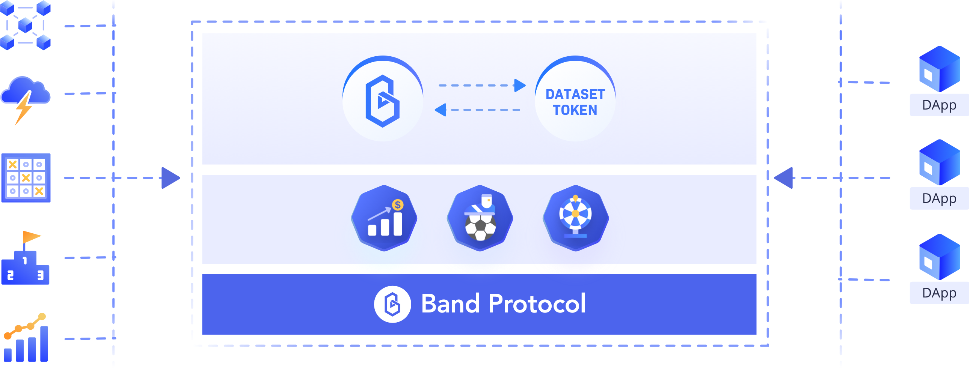
What is Band Protocol (BAND)? Which Advantages Does It Offer?
Band Protocol is a blockchain technology that can securely and verifiably incorporate data that exists in the world into blockchain technology. is a project. It is a data platform that supplies decentralized applications (dApps) with the data they may need. Band Protocol’s native cryptocurrency is BAND. In this article, we will look for answers to questions such as what is Band Protocol (BAND), what does Band Protocol (BAND) do, what are the advantages of Band Protocol (BAND).
What is Band Protocol (BAND)? What Does It Do?
A lot of data is generated as a result of events taking place in many different areas around the world. The processing of this data also leads to the emergence of valuable information. Everyone needs information, and the information transformed from data can be the engine that drives many industries forward. Band Protocol sits at the center of this data transfer process between the real world and the blockchain.
Band Protocol is a decentralized data oracle platform. It connects real-world data to APIsand smart contracts. It is responsible for exchanging information between on-chain and off-chain data sources for decentralized applications (dApps). If you are thinking, “The working logic of Band Protocol is a bit up in the air for me.”, the following example clearly explains what purpose Band Protocol serves.
Take, for example, a decentralized insurance application. Let’s imagine that this app can insure users for damages caused by natural disasters. Insurance policies are created using smart contracts, which state that the user must provide weather data in order to claim compensation.
This is exactly where the task of Band Protocol begins. Band Protocol can access various weather data providers to provide weather data. Band Protocol collects real-time weather data from these data providers. One of the conditions specified in the user’s insurance policy is the occurrence of a specific weather condition. For example, wind speed exceeding a certain threshold can represent a weather condition. The user submits weather data to the smart contract to claim compensation.
Band Protocol uses the real-time weather data it collects to verify or deny the user’s claim for compensation. This validation process is accomplished by comparing data from multiple data sources and achieving consensus. If the weather data matches the specified conditions, Band Protocol validates the smart contract and processes the user’s compensation claim. The user can receive the amount of compensation specified in their policy.
Band Protocol works as a decentralized oracle, allowing the user to integrate reliable and verifiable weather data into the insurance smart contract. Using multiple data sources improves data accuracy and reduces the risk of manipulation. This was just an example of using data on a single field. Band Protocol is a platform for financial, sports, voting, geographic, etc. services to make life easier. collects data from many areas and transforms it into useful information.
BAND, the Band Protocol’s native cryptocurrency, is used to enable participation in governance processes and to pay for collateral and services received by validators.
What Advantages Does Band Protocol (BAND) Offer?

In order to enable decentralized applications to reliably access real-world data and to encourage the adoption of blockchain-based applications, Band Protocol offers the following advantages.
Decentralized Data Access:
Band Protocol enables decentralized applications to access real-world data in a decentralized way. Band Protocol provides fast access to reliable and verifiable data and enables decentralized applications to run independently.
Data Security:
Band Protocol uses the advantages of cryptography and smart contracts to ensure data security. It operates in conjunction with decentralized verification mechanisms to prevent manipulation of data.
High Performance:
Band Protocol is a high-performance data supplier. It uses multi-blockchain technology and quickly aggregates data from different data sources. This enables decentralized applications to access instant and up-to-date data.
Wide Data Source Support:
Band Protocol provides access to multiple data sources. This makes it possible to use different types of data and enables decentralized applications to use real-world data from a variety of industries.
Flexibility and Privatization:
Band Protocol can be flexibly customized according to the needs of different decentralized applications. Band Protocol’s Smart Contract Library allows developers to integrate and customize different data sources.
Real World Applications:
Band Protocol offers many use cases for real-world applications. For example, it can be used in various sectors such as financial markets, prediction markets, insurance sector, gaming industry.
Variability and Flexibility:
Band Protocol can combine data from multiple data sources and filter it to ensure an appropriate result. This makes it possible to meet more complex data demands.
How does Band Protocol (BAND) Work?

Band Protocol works as a layer-2 oracle protocol that connects on-chain applications to external data providers. The dApp on the blockchain chooses Band Protocol to access data available online from trusted sources on Web 2.0 and Web 3.0. Band Protocol applies a multi-token model and staking mechanism to ensure that the information reaching dApps is accurate and free from manipulation. On the other hand, developers using Band Protocol can build a wide range of dApps on-chain while relying on valid, secure financial data from off-chain sources.
Band Protocol greatly reduces the risk of fake or manipulated information reaching the blockchain. And it connects on-chain applications with off-chain data providers faster and more securely than most intermediaries in the market.
When an oracle script is started to run, the following step-by-step process starts.
- A dApp requests data according to a customized oracle script.
- This request is forwarded to a randomly generated group of validators, which performs the response by pulling data from the targeted data source.
- Data reports from different validators are aggregated together according to customized oracle scripts.
- This final aggregated data is stored on BandChain and an oracle data proof is created.
- The verified oracle data is transferred to the dApp or blockchain that made the request.
Who are the Founders of Band Protocol (BAND)?

Band Protocol was created and released in 2017 by Soravis Srinawakoon, Paul Chonpimai and Sorawit Suriyakarn.
Soravis Srinawakoon is the co-founder and current CEO of the project. Soravis Srinawakoon holds a Bachelor’s degree in Computer Science from Stanford University and a Master’s degree in Business Science and Engineering, also from Stanford University. Soravis Srinawakoon started his career in software design and user testing at Freewill Solutions and his next step was to work as a software engineer at Ericsson. He later served as a lecturer at Stanford University and, prior to founding Band Protocol, most recently as a management consultant at The Boston Consulting Group.
Paul Chonpimai is co-founder of the project and currently serves as chief product officer (CPO). Paul Chonpimai, who first worked as a web developer at Turfmapp, took part in an internship program as a software engineer at TripAdvisor before Band Protocol and made many innovations within the company.
Sorawit Suriyakarn is the co-founder of the project and currently serves as CTO. Sorawit Suriyakarn holds a Bachelor’s degree in Computer Science and Engineering from the Massachusetts Institute of Technology and a Master’s degree in Electrical Engineering and Computer Science from the same university. Sorawit Suriyakarn started his career as a software engineer at MemSQL and worked in the same position at his next company DropBox. Afterwards, he was a lecturer at the Massachusetts Institute of Technology and continued to work as a software engineer in the infrastructure area of Quora. Prior to launching Band Protocol, he was a core developer at Hudson Rive Trading, working in risk and order entry.
What Other Things to Know About Band Protocol (BAND)?
To find out a little more about Band Protocol (BAND), it is useful to look at the answers to some of the following questions.
Which blockchain is the BAND token on?
The BAND token was originally created on the Ethereum blockchain in accordance with ERC-20 standards. It was then migrated to the Cosmos network and finally built on BandChain.
Is the BAND token mined?
BAND is not mined. However, rewards can be earned as a result of staking.
How to buy a BAND token?
To buy BAND tokens, it is sufficient to create a membership at ICRYPEX. Once the membership process is complete, other cryptocurrencies including BAND token can be traded quickly, easily and securely.
How to Become a Member of ICRYPEX?
After visiting www.icrypex.com from a browser, you can click on the “SUBSCRIBE” button at the top right of the page, fill in the required information and you can easily create your membership.
From mobile devices, primarily;
Android users can download our app by clicking here, Apple users by clicking here and HUAWEI users by clicking here. After logging in to the application, you can click on the menu icon at the top left, then click on “SUBSCRIBE” to fill in the required information and easily create your membership.